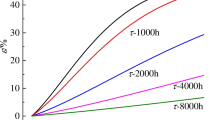Abstract
For describing the time-dependent mechanical property of rock during the creep, a new method of building creep model based on variable-order fractional derivatives is proposed. The order of the fractional derivative is allowed to be a function of the independent variable (time), rather than a constant of arbitrary order. Through the segmentation treatment, according to different creep stages of the experimental results, it is found that the improved creep model based on variable-order fractional derivatives agrees well with the experimental data. In addition, the fact is verified that variable order of fractional derivatives can be regarded as a step function, which is reasonable and reliable. In addition, through further piecewise fitting, the parameters in the model are determined on the basis of existing experimental results. All estimated results show that the theoretical model proposed in the paper properly depicts the creep properties, providing an excellent agreement with the experimental data.










Similar content being viewed by others
References
Bagley RL, Torvik PJ (1983) A theoretical basis for the application of fractional calculus to viscoelasticity. J Rheol 27:201–210
Bagley RL, Torvik PJ (1986) On the fractional calculus model of viscoelastic behavior. J Rheol 30:133–155
Chan KS, Bodner SR, Fossum AF, Munson DE (1997) A damage mechanics treatment of creep failure in rock salt. Int J Damage Mech 6:121–152
Chen BR, Zhao XJ, Feng XT, Zhao HB, Wang SY (2014) Time-dependent damage constitutive model for the marble in the Jinping II hydropower station in China. Bull Eng Geol Environ 73:499–515
Fabre G, Pellet F (2006) Creep and time-dependent damage in argillaceous rocks. Int J Rock Mech Min Sci 43:950–960
Hou Z, Wundram L, Meyer R, Schmidt M, Schmitz S, Were P (2012) Development of a long-term wellbore sealing concept based on numerical simulations and in situ-testing in the Altmark natural gas field. Environ Earth Sci 67:395–409
Koeller RC (1984) Applications of fractional calculus to the theory of viscoelasticity. J Appl Mech 51:299–307
Munson DE (1997) Constitutive model of creep in rock salt applied to underground room closure. Int J Rock Mech Min Sci 34:233–247
Podlubny I (1999) Fractional Differential Equations. Academic Press, London E2
Ramirez LES, Coimbra CFM (2007) A variable order constitutive relation for viscoelasticity. Ann Phys 16:543–552
Smit W, De Vries H (1970) Rheological models containing fractional derivatives. Rheol Acta 9:525–534
Wang G (2004) A new constitutive creep-damage model for salt rock and its characteristics. Int J Rock Mech Min Sci 41:61–67
Wang J, Zou B, Liu Y, Tang Y, Zhang X, Yang P (2014) Erosion-creep-collapse mechanism of underground soil loss for the karst rocky desertification in Chenqi village, Puding county, Guizhou, China. Environ Earth Sci 72:2751–2764
Welch SWJ, Rorrer RAL, Duren JRG (1999) Application of time-based fractional calculus methods to viscoelastic creep and stress relaxation of materials. Mech Time Depend Mater 3:279–303
Wu X, Jiang XW, Chen YF, Tian H, Xu NX (2009) The influences of mining subsidence on the ecological environment and public infrastructure: a case study at the Haolaigou iron ore mine in Baotou, China. Environ Earth Sci 59:803–810
Wu Q, Niu F, Ma W, Liu Y (2014) The effect of permafrost changes on embankment stability along the Qinghai-Xizang Railway. Environ Earth Sci 71:3321–3328
Xu B, Yan C, Lu Q, He D (2014a) Stability assessment of Jinlong village landslide, Sichuan. Environ Earth Sci 71:3049–3061
Xu T, Xu Q, Deng M, Ma T, Yang T, Tang CA (2014b) A numerical analysis of rock creep-induced slide: a case study from Jiweishan Mountain, China. Environ Earth Sci 72:2111–2128
Yang CH, Daemen JJK, Yin JH (1999) Experimental investigation of creep behavior of salt rock. Int J Rock Mech Min Sci 36:233–242
Yin D, Zhang W, Cheng C, Li Y (2012) Fractional time-dependent Bingham model for muddy clay. J Non Newton Fluid Mech 187:32–35
Zhou H, Jia Y, Shao JF (2008) A unified elastic–plastic and viscoplastic damage model for quasi-brittle rocks. Int J Rock Mech Min Sci 45:1237–1251
Zhou HW, Wang CP, Han BB, Duan ZQ (2011) A creep constitutive model for salt rock based on fractional derivatives. Int J Rock Mech Min Sci 48:116–121
Zhou HW, Wang CP, Mishnaevsky L Jr, Duan ZQ, Ding JY (2013) A fractional derivative approach to full creep regions in salt rock. Mech Time Depend Mater 17:413–425
Acknowledgments
The authors are grateful for the financial support from the National Natural Science Foundation of China (Grant No. 51120145001, 51374148), the National Basic Research Projects of China (Grant No. 2011CB201201), and the Fundamental Research Funds for the Central Universities (Grant No. 2014SCU04A07). The authors wish to offer their gratitude and regards to the colleagues who contributed to this work.
Author information
Authors and Affiliations
Corresponding author
Rights and permissions
About this article
Cite this article
Wu, F., Liu, J.F. & Wang, J. An improved Maxwell creep model for rock based on variable-order fractional derivatives. Environ Earth Sci 73, 6965–6971 (2015). https://doi.org/10.1007/s12665-015-4137-9
Received:
Accepted:
Published:
Issue Date:
DOI: https://doi.org/10.1007/s12665-015-4137-9




